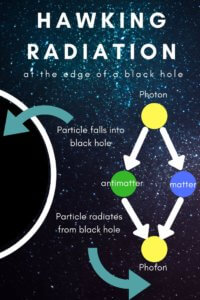The recent death of Professor Stephen Hawking has affected many people. Since the success of his best-selling book, A Brief History of Time in the 1980s, Hawking came to symbolise science itself and an archetypical ‘clever person’ with mysterious knowledge of the universe. That he had to overcome great difficulties due to a debilitating illness seemed to add to his charisma.
But it was not his public image that I was interested in but his science. Stephen Hawking had pioneering ideas about black holes that would profoundly affect me. So in the article, I wish to discuss the topic of Stephen Hawking and me.
Public Image vs Science
I never met him and I didn’t particularly wish to either. For me, he didn’t hold the glamour that he did for so many. Of course, I saw him as a courageous person who despite his physical situation, stood up for human rights and used his celebrity to draw attention to various causes and I admired him for that.
The general public saw him as the greatest scientist of our era. In the minds of many scientists, it was a different picture; he was seen a great science writer and communicator but most of what he wrote about in his best-selling books and his TV series was not his own ideas but the prevailing views in science that he elegantly and wittily conveyed to the public. You could argue that his greatest legacy was his substantial wit.
A Rebel Idea
But there was something else that in the furore over his celebrity that often gets overlooked. He was one of the first people to say that something could escape the vicinity of a black hole, thus daring to challenge orthodox concepts. He described his discovery in his famous book, A Brief History of Time and how the insight came to him as he was getting ready for bed in the early 1970s.
Back then, the concept of a black hole was fairly new. It was thought that they are dark, guzzling monsters ready to suck in everything in their path. Hawking realised that the quantum vacuum also exists in the vicinity of black holes. Virtual particles cycle from light to matter and antimatter and back again, just as in the rest of the universe.
He postulated that one of the particles may fall in and the other may be radiated out, which contradicted the concept that nothing could escape from black holes. Hawking realised that they weak radiation could escape black holes. This is called Hawking radiation and it was this concept that would provide one of the stepping stones for The Black Hole Principle.
The Path Begins
One day when I was browsing through a Waterstones bookstore in Hampstead, a book dropped off the shelf in front of me. It was called The Nature of Space and Time by Stephen Hawking and Roger Penrose. I bought the book but was unable to understand much of the technical text.
Nevertheless, the incident made me look more into Hawking radiation. Later, when I had the vision which gave me The Black Hole Principle, I knew I was looking at Hawking radiation in action.
I knew, however, it wasn’t due to the destructive nature of black holes (which is a false concept) but their creative properties. At the edge of a black hole, particles of light split into antimatter and matter and are seen as radiation.

This indeed correlates with the data we glean from telescopes – matter and antimatter coming from the centre of galaxies at near light speeds and we measure streams of electrons come from the edge of a black hole. Although this is similar to Hawking radiation, he expected it to be much weaker.
A Lost Opportunity?
Nobel prizes are given once a prediction about the universe has been proven by observation. In my opinion, the evidence for Hawking radiation has been staring us in the face but nobody else has put the pieces together.
For many years I have finished my workshops by saying that we have just won Stephen Hawking the Nobel prize. Sadly I never got to tell him and he never did win the Nobel prize. He leaves this earthly plane not knowing just how right he was.
If you would like to know more about The Black Hole Principle and how it can affect your life, check out Simply Divine: an Easy Guide to the Science of Spirituality.




Well you could be a fairly good candidate for a future Nobel, or a Lasker if you write about how the BHP correlates with health, remarkable recoveries/spontaneous remissions, etc. Have you read “Suggestable You?”
No – haven’t read it. The BHP as it stands makes a lot of predictions that have been right. That alone is more than some Nobel winners – RNA first anyone? Thanks.
i shared the same thing with her years ago! i believe in 2007 i told manjir she will receive a novel prize. i still feel strongly that she will and i love it!!! punk science is the most amazing book! genius groove as well. and now all of these blog entries are such a blessing! much love
I remember you saying that to me, bless you.